Should I Adopt a Blind Dog?
Short answer: Absolutely. After a little preparation, you’ll find immense ease and satisfaction in opening your home to a sight-impaired pup.
Short answer: Absolutely. After a little preparation, you’ll find immense ease and satisfaction in opening your home to a sight-impaired pup.
by Adrienne A. Kruzer, BBA, RVT, LVT, | June 14, 2024

makam1969 / Adobe Stock
As you can imagine, adopting a blind dog comes with extra responsibilities. But the tradeoff is that opening your home to a visually impaired canine can lead to a deeply rewarding bond — not to mention giving you the satisfaction of providing a safe, loving environment for a special-needs pet.
It’s normal to feel a little apprehensive about adopting a special-needs dog. But once you familiarize yourself with everything it entails, you’ll learn that raising a blind pup isn’t much different than living with any other dog — because canines are smart, adaptive, and appreciative. What are some blind dog care considerations to keep in mind? Read on to learn all about raising these amazing dogs.
Caring for a blind dog is a lot like caring for a sighted dog. Despite these similarities, there are a few considerations you’ll need to make as you learn how to take care of a visually impaired dog.
Unlike a dog who can see potential dangers in your home, a blind dog may not be able to avoid things that could hurt them, particularly in new environments. So you’ll want to make sure your home is safe for their arrival. Steps, sharp objects, pools, doors, wires on the ground, decorative items that are easily knocked over, and windows and walls can all cause issues. If you can’t remove something from your home, it may be best to keep your blind dog away from those potential dangers altogether.
Baby gates and exercise pens can be used for safety purposes, to keep your dog in a certain area of your home. If there’s something at your dog’s height that could poke them, be knocked over, or trip them, these items should be moved or removed from the area your dog will be in. If you’re not sure what could be problematic, try closing your eyes while crawling around the house (while having someone monitor you for safety). You may be surprised by the potential dangers that you wouldn’t have otherwise noticed.
Since a blind dog can’t see your hand signals, you should utilize sounds, textures, and smells to train and communicate with your blind dog. Training clickers, happy voices, petting, noisy toys, and treats are great rewards to use with a blind dog during training. For safety purposes, keep your dog on a leash as they learn to follow your voice and find their way around your home. Additionally, textured rugs can also help them learn which rooms they are supposed to be in (or not be in).
Once you’ve prepared a safe space for your dog, exercising them is easy. Walking them outside on a leash, allowing them to explore in a secured yard, and playtime with scented or noisy toys will help keep your blind dog physically fit. Despite how well they are trained, you should always supervise your blind dog when they are playing outside.
In addition to physical activity, you’ll want to provide your blind dog with some mental stimulation. Scented activities are great. They can include puzzles and chew toys containing treats or coated with edible, smelly liquids like corn syrup and vanilla extract. You can even hide scented toys under blankets or pillows or other safe items that your blind dog can sniff.
Most blind dogs are just as interested in socializing and interacting with other dogs as a sighted dog might be, but introductions should be slow and controlled. When introducing your blind dog to another dog, put both dogs on leashes and pay close attention to their body language. Allow each dog to sniff and get to know each other, but pull them away from each other if either one appears to get nervous or show signs of aggression. Keep in mind that each dog will differ: Some may be afraid of other dogs, while others may prefer to have a pal who can guide them around. So it’s never a good idea to force a canine buddy on your blind dog.
Anxiety can easily occur in blind dogs if their environments are quickly changing, so the key to managing their anxiety is to take things slow. Gradually introduce them to a new home and to new people and pets. Give them time to explore any changes to their environment if you are traveling, remodeling, or redecorating.
Any veterinarian who is comfortable treating dogs can care for a blind dog. If your dog is blind because of a specific disease, is a senior, or needs behavioral assistance, some veterinarians may be more experienced than others. Veterinary ophthalmologists, behaviorists, and those experienced in treating blindness-causing diseases may all be beneficial in helping you care for your new dog. Occasionally, blindness can be corrected, so it’s important to have your dog thoroughly examined by a veterinarian upon adoption.
Taking care of a blind dog doesn’t have to be difficult. There are a variety of accessories available to help keep your dog safe and entertained.
All dogs, including blind ones, should have a collar or harness and leash. It’s a good idea to use a harness on a blind dog even if you aren’t on a walk, just in case you need to prevent them from walking into a dangerous situation. Leashes are a must-have during all walks, even if your blind dog has your daily route memorized, in case you need to guide them away from a hazard.
If you’re worried about your dog walking into something that could hurt their eyes, consider getting them some protection. Special dog goggles and visor shields can be purchased to prevent your dog from hurting their eyes. Just because your dog can’t see, doesn’t mean they don’t feel pain if they damage their eyes.
These devices may look silly, but they are very useful in keeping your blind dog safe. If your dog regularly walks into walls, windows, and furniture, a halo or bumper device will stop them before they hurt themselves.
Scented dog toys for blind dogs provide hours of mental and physical stimulation. These allow your dog to utilize their strong sense of smell to have fun. Other products for blind-dog playtimes include toys with different textures they can explore with their mouths and feet, as well as noisy toys. Toys that move or shake can be startling to a dog that can’t see, so these are best avoided if you’re looking for different gifts for blind dogs to enjoy.
If you are specifically looking to adopt a blind dog, it’s helpful to be open to a variety of ages and breeds. This will increase your chances of quickly finding a visually impaired friend. If you’re ready to welcome a new dog into your life, use Adopt a Pet’s search feature to find your new family member today.
There are rescue groups and shelters dedicated to helping blind dogs of all ages, especially for the breeds that are more prone to blindness. Some dogs are born blind, while others go blind because of age or disease. If you are willing to adopt an older dog, it won’t be very hard to find a visually impaired dog in need of a home. A few blind dog rescues to consider include:
Dogs can vary greatly in cost. The initial purchase or adoption price is a one-time fee. But ongoing costs will include vet visits, boarding, toys, groomings, medications (including preventative), and of course, food and treats. A variety of factors go into determining how much it will cost to care for a dog, but a good starting point is to budget for about $2,000 a year. Larger dogs usually cost more to care for than small dogs, and overall, healthcare typically requires the largest expenses.
Each special-needs dog is different from the other — that’s why they are special. However, most special-needs dogs often require medications and care that can be more time-consuming and costly. For instance, you may need assistance with taking them outside. Medications may be required at specific times of the day. And sometimes you’ll need to make some changes to your home to keep a special-needs dog safe. If you’re looking for a unique dog and are willing to provide them with what they need to thrive, consider opening your home up to a special-needs dog.

Adrienne Kruzer is an accomplished veterinary technician and writer with over 15 years of hands-on experience caring for domestic and exotic animals.
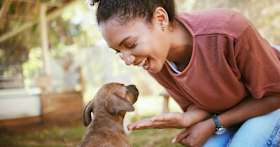
Adoption Advice

Shelters & Rescue

Adoption Advice
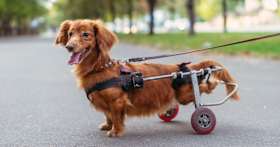
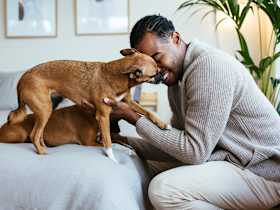
Adoption Advice
Adopting a dog is a BIG decision. If you’re considering getting a new pup, consider a foster-to-adopt program to test the waters first.

Adoption Advice
Is the responsibility of taking care of your pet causing you to worry about your budget? Rest assured, there are a number of ways to minimize this financial stress.
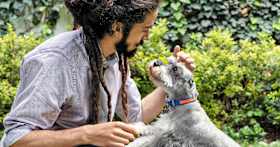
Adoption Advice
While you’ll need to monitor your pet’s blood sugar, it’s not nearly as involved as you’d think.
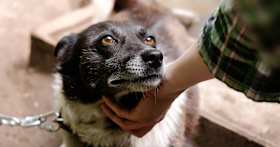
Shelters & Rescue
If you suspect animal cruelty in your community, here’s how you can help stop the mistreatment as soon as possible.
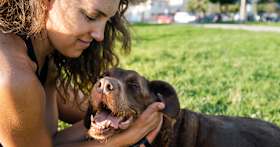
Adoption Advice
These studies prove that dogs’ awesomeness is more than just a vibe.
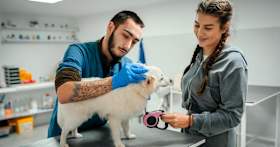
Adoption Advice
Pet parenthood can be tough, but finding the right vet doesn’t need to be. These tips will help you find the right vet for your pup.

Shelters & Rescue
Looking to adopt? Here are some helpful guidelines on finding a reputable pet rescue organization.

Adoption Advice
Are you finalizing a new pet’s adoption? Learn everything you need to know about pet adoption paperwork.